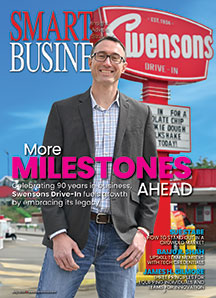Whatever industry we scan, e-commerce is the future of business as we know it.
The Akron Regional Development Board recently added an interactive feature to its Web site, which offers its 2000 members the option of communicating with each other through the site.
The impact of this feature has been most significant for the ARDB staff, which attributes a 50 percent decline in the management of inquiry calls from members, students and educators to the new feature. This has liberated staff time for the information management and research tasks that drive value to members.
“It’s gotten us a lot more efficient in house,” says Rebecca Guzy Woodford, ARDB’s senior director of research and communications.
Without changing ARDB’s mission, the Web has become an efficient information distribution method.
“We’re still in the same information business,” notes Woodford. “We don’t see e-commerce as a change in our mission — just more added value.”
The ARDB is planning to add more value to the site by creating a B2B e-commerce portal, now in the formation phases of development. With the ability to attract, recruit and promote business growth in the region, Woodford projects the organization’s future Web strategies will allow it to “be more focused and provide more services.”
U.S. Office Products’ (which bought out locally-based Costigan’s) venture into the e-landscape began in 1993 with direct dial modem-to-modem hook-ups. Although Web sales increased more than 30 percent last year, many of the company’s customers still rely on fax and phone transactions, largely because of customer access, bandwidth and adaptability to change issues.
Today, its Web catalog boasts more than 25,000 items, fulfilled within 24 hours. Even at the current level of customer acceptance, “our Web-based business has changed the organization dramatically,” says Richard Costigan, vice president of business development. Customer service representatives inputting orders “now have the ability to provide true customer service.”
This aligns well with the fact that most customer service reps prefer interaction and solution development with customers rather than the restricted venue of key punching and input processing.
The challenge has been to help customers embrace the new media. According to Costigan, “as much as we promote (our e-commerce) with incentives, training and promotions, change is hard for people.”
U.S. Office Products’ e-sales picture is bright nevertheless. E-commerce has fed sales growth, punctuated by the fact that last year, all of the company’s new customers were Web-based.
Advanced Elastomer Systems, an Akron manufacturer of thermoplastic elastomers, is eagerly instituting the launch of its e-commerce strategies. According to Margaret Mattix, AES’ senior vice president of E-Business and Strategic Alliances, AES sees its Web site as “a very effective tool for increasing reach and supplying information in a cost-effective way.”
Even with a healthy 12- to 18-month sales cycle, e-business payoffs are already being calculated.
As Mattix indicates, “There’s a cross-section of employees who are very capable, excited and supportive, and if you can tap into that, they can help middle managers who may see this as a threat to their need to be in control.”
As AES management has learned, the transition to e-business and e-commerce requires more adaptability than control. Employees who bring a personal Web enthusiasm and savvy are utilized to help demystify fears and energize managers.
AES has discovered that a commitment to e-business is a commitment to eliminating fear in the organization — fear of the loss of control, not being in mastery over new technologies and the hyped fear of job loss. At AES, this effort has been facilitated by the fact that the company began the process with a strong ERP system.
So far, customer reactions have been a mix of excitement and wait-and-see reluctance. Because commerce is a relationship, moving the customer forward has become as important as moving the organization forward. To this end, AES has smartly collaborated with 10 “competitor” raw material suppliers to form ElastomerSolutions.com, an industry-specific marketplace for light e-commerce and information exchange.
As far as e-business impacting the AES core mission, Mattix isn’t worried. As she suggests, embracing e-business and e-commerce “doesn’t really change who we are — only how we do it.”
From the technology expert side, Akron-based Interactive Media Group provides empathy and cross-industry Web design experience. According to IMG President Andrew Holland, many companies launch an ambitious or cautious courting of e-business with considerations of supply cost management. This is especially beneficial for companies selling late-cycle commodities that compete for fractions of market share.
Other objectives getting equal play are focused on using e-business to support field sales and to provide multiple points of access.
The biggest challenge for any successful e-business plan is making sure all of the company’s disciplines are, in Holland’s words, “getting their silo ‘Towers of Babel’ together.” Marketing, engineering and operations must be equal partners in e-strategies, since at the end of the day, each significantly impacts and is impacted by business mediated by the Web.
Holland has found that although e-business doesn’t dismantle the corporate mission, it does call for a significant reinvention of how business is done — in many cases, with commensurate rewards from an equally ready marketplace.
“Companies must understand that creating an electronic channel has an advantage in terms of bricks-and-mortar and traditional sales force investments,” Holland says. “Each of the elements of service must be examined in the light of the products and services that are being delivered. If they are not existent in the traditional organization, they must be created. If they are currently in place, they must be analyzed and effectively translated into the new electronic channel.”
Without hyped reliance on feckless forecasts, it seems clear that businesses are already moving productively and intelligently into a venue that shows evolutionary promise.
Though no two companies may move in the same way or at the same pace, the next economies will be significantly energized by the next technologies and innovative applications used by growing enterprises.
Jack Ricchiuto is a management consultant and author.

